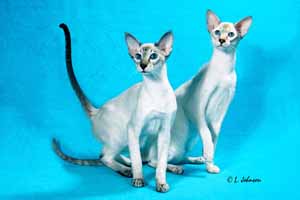


Photo courtesy of Larry Johnson Photography.
First imported to the United States in the 1880s, Siamese are the most extroverted of all cat breeds. They are also the most vocal, with a deep yowling that is unmistakable. Siamese are affectionate and loyal, love to be held and do not like being left alone. Tolerant and energetic, they make excellent playmates for children.
Breed-related concerns
Every cat breed carries a distinct set of genetic advantages and health risk factors. The following are the most common diseases found in the Siamese breed. Hopefully, your Siamese will not face these problems. However, early detection and preventive healthcare can make all the difference in helping your cat live a longer, happier life (see breed related disease descriptions below).
Kitten (birth to 1 year)
Adult (1 to 6 years)
Senior (7 years and older)
Breed-related disease descriptions
Listed in alphabetical order
Corneal sequestrum. Black discoloration within the cornea (the clear window of the front of the eye). Clinical signs include black discoloration to the cornea and signs of eye pain (squinting, keeping the eye closed, keeping the third eyelid over the eye or excessive tearing).
Excessive vocalization. Frequent yowling noises. Siamese cats are much more likely to do this (genetically predisposed). The behavior is often enhanced by owners who find this yowling endearing and tend to “answer” the cat when it “speaks.” For some cats, this attention is very rewarding, which makes their yowling more frequent. A problem then arises when the human wants to turn the yowling off, and the cat is still trying to seek attention and reward. In extreme cases, yowling may even become a form of obsessive compulsive behavior requiring behavioral therapy and medication.
Mammary cancer. Cancer of the mammary glands, which often spreads to the lymph glands and lungs. The risk for mammary cancer can be reduced by early spaying. Signs include mammary gland lumps which may rupture or bleed.
Stomatitis. Severe, painful inflammation of the mouth typically caused by an intense reaction to one or more diseases such as feline leukemia, feline immunodeficiency virus, diabetes mellitus and malnutrition. Treatment includes control and/or elimination of the disease(s), along with aggressive professional and home dental care. In some cases, the disease has advanced to a degree that home dental care is too painful.
Help your cat live a longer, healthier life. Ask your veterinarian about a breed-related preventive health plan.
Breed-related disease descriptions
Listed in alphabetical order
Corneal sequestrum. Black discoloration within the cornea (the clear window of the front of the eye). Clinical signs include black discoloration to the cornea and signs of eye pain (squinting, keeping the eye closed, keeping the third eyelid over the eye or excessive tearing).
Excessive vocalization. Frequent yowling noises. Siamese cats are much more likely to do this (genetically predisposed). The behavior is often enhanced by owners who find this yowling endearing and tend to “answer” the cat when it “speaks.” For some cats, this attention is very rewarding, which makes their yowling more frequent. A problem then arises when the human wants to turn the yowling off, and the cat is still trying to seek attention and reward. In extreme cases, yowling may even become a form of obsessive compulsive behavior requiring behavioral therapy and medication.
Mammary cancer. Cancer of the mammary glands, which often spreads to the lymph glands and lungs. The risk for mammary cancer can be reduced by early spaying. Signs include mammary gland lumps which may rupture or bleed.
Stomatitis. Severe, painful inflammation of the mouth typically caused by an intense reaction to one or more diseases such as feline leukemia, feline immunodeficiency virus, diabetes mellitus and malnutrition. Treatment includes control and/or elimination of the disease(s), along with aggressive professional and home dental care. In some cases, the disease has advanced to a degree that home dental care is too painful.
Help your cat live a longer, healthier life. Ask your veterinarian about a breed-related preventive health plan.